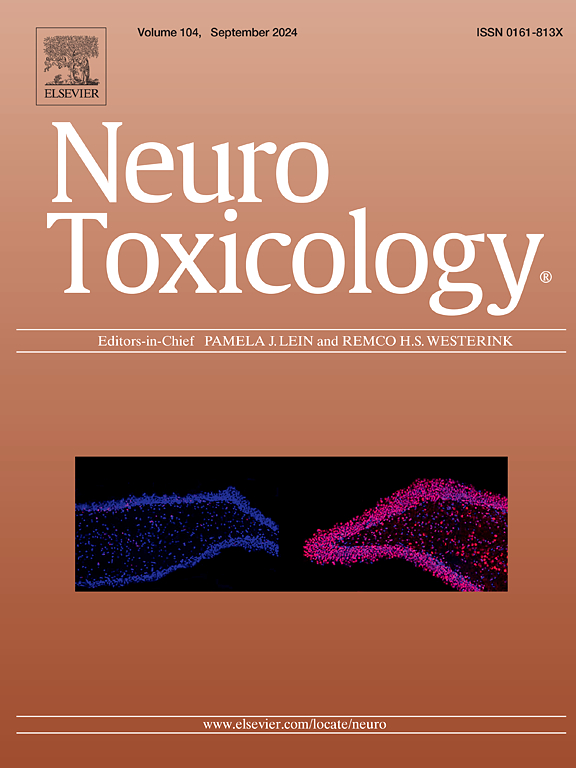七氟醚暴露在秀丽隐杆线虫和小鼠体内通过诱导内质网应激导致持久性学习和记忆障碍
IF 3.9
3区 医学
Q2 NEUROSCIENCES
引用次数: 0
摘要
在啮齿动物和非人灵长类动物模型中,在出生后发育早期暴露于全身麻醉剂与持久的认知缺陷有关。然而,吸入麻醉剂诱导神经元死亡和突触改变的机制尚不清楚。给线虫和新生雄性小鼠注射七氟醚。随后,我们评估了它们的学习和记忆能力,并探讨了影响秀丽隐杆线虫和小鼠学习和记忆的潜在机制。结果秀丽隐杆线虫发育早期暴露于七氟醚导致学习和记忆障碍。eif31和ced-3基因在七氟醚诱导的秀丽隐杆线虫发育性神经毒性中起关键作用。内质网应激是七氟醚致秀丽隐杆线虫发育性神经毒性的可能机制。在新生小鼠中,七氟醚诱导海马神经元内质网应激,不依赖于eif31,可通过TUDCA(牛磺酸去氧胆酸,一种内质网应激抑制剂)缓解。此外,在新生期暴露于七氟醚的成熟小鼠海马突触功能下降,TUDCA减轻了这一现象。在新生儿期暴露于七氟醚的成年小鼠观察到持续的认知功能障碍,TUDCA减轻了这种功能障碍。结论发育早期暴露于七氟醚可引起内质网应激,导致记忆和学习能力下降。TUDCA可能会缓解这些影响。本文章由计算机程序翻译,如有差异,请以英文原文为准。
Sevoflurane exposure in juvenile causes persistent learning and memory impairment via inducing endoplasmic reticulum stress in caenorhabditis elegans and mice
Background
Exposure to general anesthetics during early postnatal development is linked to enduring cognitive deficits in rodent and non-human primate models. However, the mechanisms by which inhaled anesthetics induce neuronal death and synaptic alterations remain unclear.
Methods
C. elegans and neonatal male mice were administered sevoflurane. Subsequently, their learning and memory capabilities were assessed, and the potential mechanisms influencing learning and memory in C. elegans and mice were explored.
Results
Early developmental exposure to sevoflurane resulted in learning and memory impairment in C. elegans. The eIF3l and ced-3 genes are critical for sevoflurane-induced developmental neurotoxicity in C. elegans. Endoplasmic reticulum stress is a possible mechanism underlying developmental neurotoxicity induced by sevoflurane in C. elegans. In neonatal mice, sevoflurane induced endoplasmic reticulum stress in hippocampal neurons independently of eIF3l, which was mitigated by TUDCA ( tauroursodeoxycholic acid, an ER stress inhibitor). Additionally, mature mice exposed to sevoflurane during the neonatal period exhibited decreased synaptic function in the hippocampus, which was alleviated by TUDCA. Persistent cognitive dysfunction was observed in adult mice exposed to sevoflurane during the neonatal period, which was alleviated by TUDCA.
Conclusion
Our findings demonstrate that early developmental exposure to sevoflurane induces endoplasmic reticulum stress, which may result in a decrease in memory and learning capabilities. TUDCA may alleviate these effects.
求助全文
通过发布文献求助,成功后即可免费获取论文全文。
去求助
来源期刊

Neurotoxicology
医学-毒理学
CiteScore
6.80
自引率
5.90%
发文量
161
审稿时长
70 days
期刊介绍:
NeuroToxicology specializes in publishing the best peer-reviewed original research papers dealing with the effects of toxic substances on the nervous system of humans and experimental animals of all ages. The Journal emphasizes papers dealing with the neurotoxic effects of environmentally significant chemical hazards, manufactured drugs and naturally occurring compounds.
 求助内容:
求助内容: 应助结果提醒方式:
应助结果提醒方式:


